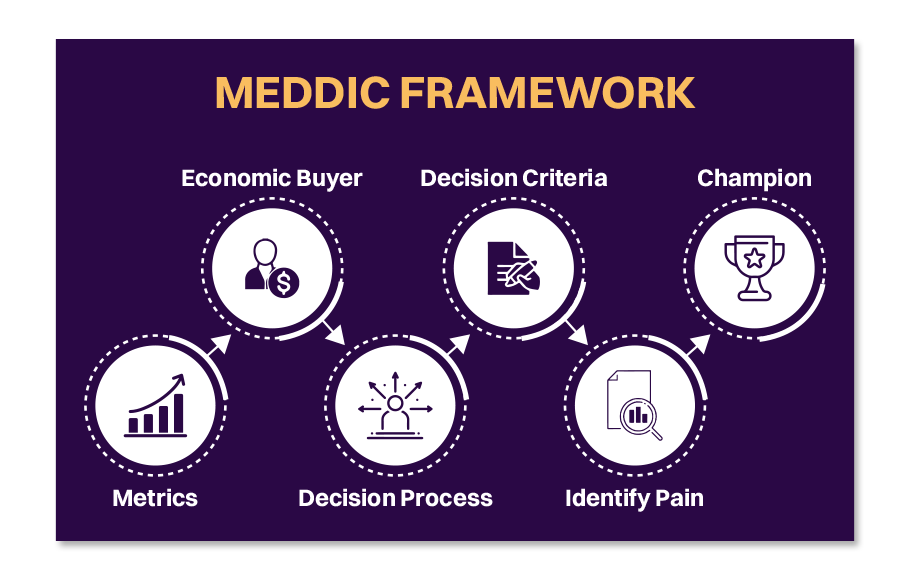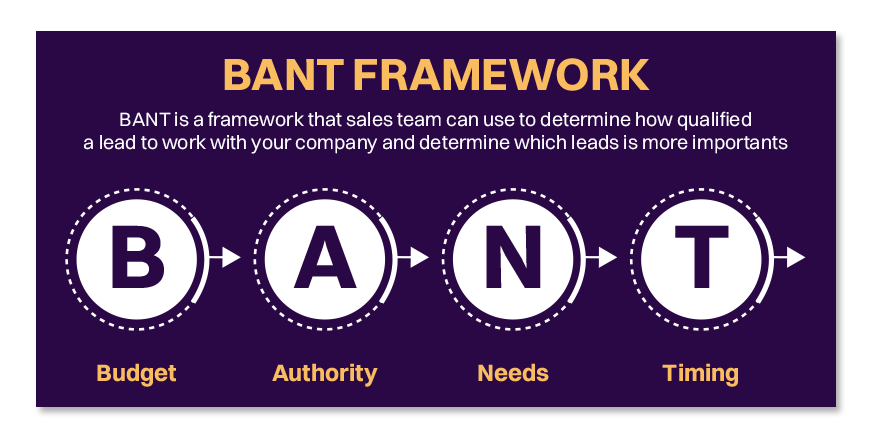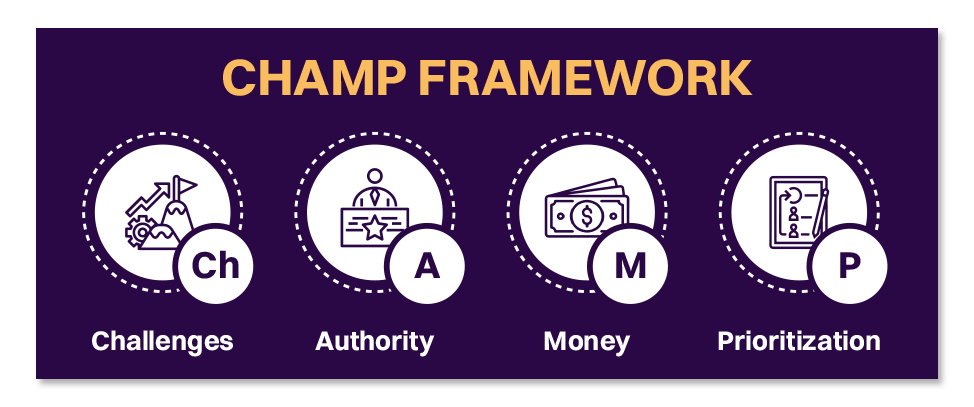
Sales Lead Qualification Frameworks (MEDDIC vs BANT vs CHAMP)
Did you know that implementing effective sales lead qualification frameworks can boost your sales success by a whopping 67%? That's an impressive statistic, right?
In today's highly competitive business landscape, identifying and prioritizing suitable leads is crucial for driving revenue and maximizing sales efficiency. That's where sales lead qualification frameworks like MEDDIC, BANT, and CHAMP come into play.
This article dives deep into sales lead qualification frameworks and compares the popular contenders: MEDDIC, BANT, and CHAMP. As an expert demand generation service provider, our primary goal is to assist you in comprehending the value of various frameworks and selecting the one that best meets the requirements of your sales force.
So, let's delve into the world of MEDDIC, BANT, and CHAMP, explore their strengths and weaknesses, and empower you to supercharge your sales efforts.
Sales Lead Qualification Frameworks: The Know-How!
Sales Lead Qualification Frameworks are systematic approaches to evaluating and prioritizing your potential sales leads. They give your sales teams a systematic way to assess each lead's feasibility and potential, enabling them to concentrate on the most attractive possibilities.
These sales lead qualification methods act as a roadmap, guiding your sales representatives through the qualification process and helping them make informed decisions.
So why use these frameworks in the first place? The main objective is to separate the wheat from the chaff, ensuring that your sales teams invest their time and energy in pursuing leads more likely to convert into actual customers.
The benefits of using sales lead qualification frameworks are tremendous:
- They help save time
- Accelerate lead scoring system
- Increased sales productivity
- Enhance collaboration between sales and marketing teams
Now, let's discuss the three frameworks one by one:
1. MEDDIC Framework
According to a survey conducted by the Sales Benchmark Index (now known as Revenue Enablement Institute), companies implementing the MEDDIC sales framework experienced an average win rate increase of 25%. This significant improvement can be attributed to the MEDDIC framework's focus on thorough qualification and understanding of the buyer's journey.
Components of the MEDDIC Framework:
- Metrics: Understand the specific metrics and KPIs that matter to your potential customer.
- Economic Buyer: Identify the person or group with the authority and budget to make purchasing decisions.
- Decision Criteria: Uncover your customer's specific criteria to evaluate potential solutions.
- Decision Process: Determine the steps and stakeholders involved in your customer's buying journey.
- Identify Pain Points: Identify your customer's challenges and problems and position your solution as the answer.
- Champion: Find someone internally vested in your success and willing to advocate for your solution.
 Strengths of the MEDDIC Framework:
Strengths of the MEDDIC Framework:
- A comprehensive approach that leaves every aspect of sales qualification addressed.
- Provides a systematic approach to gathering in-depth knowledge about your leads.
- Helps tailor sales strategies based on specific customer needs and pain points.
- Enhances your sales team's efficiency and effectiveness.
- Encourages collaboration and alignment between sales and other departments.
Weaknesses of the MEDDIC Framework:
- Complexity can require significant time and effort to implement effectively.
- Requires thorough training and ongoing reinforcement to ensure consistent application.
- It can be unsuitable for all sales situations or industries.
- Overemphasis on specific components can result in overlooking other essential factors.
Examples of companies successfully using MEDDIC:
- Salesforce: Utilizes the MEDDIC Framework to train its sales teams and drive revenue growth.
- IBM: Adopts MEDDIC as part of its sales process to improve customer engagement and win rates.
- Oracle: Credits MEDDIC to enhance its sales processes and enable more effective customer interactions.
If you want to know more about the MEDDIC framework and how to use it properly, check out this video made by Pipedrive that tells you all you need to know about this methodology: Sales Methodologies | MEDDIC sales process
2. BANT Framework
By qualifying leads based on their budget, decision-making authority, need for the product or service, and timeline, sales teams can focus on leads more likely to convert into paying customers. According to a study by InsideSales, companies that effectively implemented the BANT framework saw a 59% increase in their conversion rates.
Components of the BANT Framework:
- Budget: Determine if your potential customer has the financial resources to purchase.
- Authority: Identify the person or group with decision-making power within your organization.
- Need: Understand the specific needs, challenges, or pain points your customer is trying to address.
- Timeline: Determine the timeframe for your customer to purchase or implement a solution.
 Strengths of the BANT Framework:
Strengths of the BANT Framework:
- Straightforward approach that focuses on crucial qualification factors.
- It helps your sales teams quickly assess a lead's potential based on budget, authority, need, and timeline.
- Enables efficient resource allocation by prioritizing leads with higher potential.
- Provides a common language and criteria for your sales and marketing teams to align their efforts.
- Allows your sales reps to disqualify leads early if they don't meet the BANT criteria, saving time and effort.
Weaknesses of the BANT Framework:
- Limited focus on understanding your customer's decision-making process or criteria beyond budget, authority, need, and timeline.
- It doesn't consider the complexity of multi-stakeholder decision-making in larger organizations.
- Ignores the importance of building relationships and addressing customer pain beyond the initial qualification factors.
- It can be unsuitable for complex or long sales cycles where additional factors are critical for success.
Examples of companies successfully using the BANT Framework:
1. Cisco: Cisco, a leading technology company, leverages the BANT Framework to qualify leads in its sales process.
2. Microsoft: Microsoft incorporates the BANT Framework to qualify leads for their enterprise software solutions.
3. HubSpot: HubSpot, a leading marketing and sales software provider, applies a modified version of the BANT Framework.
If you are unsure how BANT works, you can check this informative and helpful guide by James White, explaining everything you need to know. Feel free to check out his video:
BANT- Learn to qualify your leads using BANT
3. CHAMP Framework
Did you know that the champ sales framework focuses on understanding the customer's needs, aligning the sales process accordingly, and providing tailored solutions? As a result, companies have observed higher win rates for their sales teams. In fact, a research report by Vantage Point Performance and the Sales Management Association found that organizations with a defined sales process achieved a 15% increase in win rates.
Components of the CHAMP Framework:
- Challenges: Identify the specific challenges or pain points your customer is facing.
- Authority: Determine the decision-making authority within the organization.
- Money: Understand the financial resources and budget available for the potential purchase.
- Prioritization: Assess your customer's priorities and determine the importance of solving their challenges.

Strengths of the CHAMP Framework:
- Focuses on understanding your customer's specific challenges and pain points.
- Places emphasis on identifying decision-making authority and understanding your customer's budget.
- Helps your sales teams tailor their approach by aligning their solutions with customer priorities.
- Facilitates meaningful conversations by addressing your customer's most pressing needs.
- Encourages your sales professionals to build relationships and become trusted customer advisors.
Weaknesses of the CHAMP Framework:
- Doesn't explicitly address the decision-making process and criteria beyond authority.
- It may not provide a comprehensive view of your customer's decision-making dynamics in complex organizations.
- Lacks a specific timeline component, potentially overlooking time-sensitive opportunities.
- Your Sales professionals must have strong questioning and listening skills to uncover challenges effectively.
Examples of companies successfully using the CHAMP Framework:
1. Adobe: a global software company, Adobe incorporates the CHAMP Framework into its sales processes.
2. SAP: SAP, a leading enterprise software provider, utilizes the CHAMP Framework to qualify leads and tailor their sales approach.
3. Amazon Web Services (AWS): AWS, a prominent cloud computing service provider, applies the CHAMP Framework in its sales strategies.
Another thing to mention is if you have any trouble figuring out the ChAMP framework in your sales strategy, here is a comprehensive video telling you all the information you need by Subhakar Rao Surapaneni: Must Watch Sales Strategies by Mr. Subhakar Rao Surapaneni- Champ Sales Framework
A Battle Royale Between MEDDIC, BANT, and CHAMP Frameworks!
Key similarities between the frameworks:
- Customer-focused: All three frameworks prioritize understanding customer needs and pain points.
- Qualification criteria: They provide criteria for assessing your leads and determining their potential.
- Alignment with sales process: Each framework can be integrated into your sales process to guide qualification and engagement.
- Decision-making authority: They emphasize identifying the key decision-makers within your customer's organization.
- Value proposition: They encourage aligning the product or solution with your customer's specific needs and priorities.
MEDDIC vs. BANT vs. CHAMP
- Level of complexity: MEDDIC tends to be more comprehensive and detailed, while BANT and CHAMP provide a simpler framework.
- Decision-making process: MEDDIC and CHAMP offer more guidance on understanding the customer's decision-making process, while BANT focuses primarily on the initial qualification factors.
- Time sensitivity: BANT considers the timeline as a factor, whereas MEDDIC and CHAMP do not explicitly address timeframes.
- Industry and sales cycle suitability: The frameworks can be more suitable for different industries or sales cycles based on their level of detail and focus.
When to use each framework:
- MEDDIC: Ideal for complex sales cycles and industries where a comprehensive understanding of the customer's decision-making process and multiple qualification factors is crucial.
- BANT: Effective for situations where initial qualification factors like budget, decision-making authority, need, and timeline are the primary considerations, especially in shorter sales cycles.
- CHAMP: Suitable for understanding and addressing your customers' challenges, determining decision-making authority, and aligning with their priorities. Particularly valuable when building relationships and becoming a trusted advisor.
Unleashing the Power of Effective Framework Implementation!
Steps to effectively implement a framework:
1. Understand your sales process: Familiarize yourself with your existing sales process to identify where the framework can seamlessly integrate.
2. Select the appropriate framework: Choose one that aligns with your industry, sales cycle, and business objectives.
3. Customize the framework: Tailor it to suit your specific needs and sales context by aligning it with your unique qualification criteria.
4. Communicate and educate: Clearly communicate the framework's purpose, benefits, and expectations to the sales team, ensuring they understand its value.
5. Provide training and resources: Offer comprehensive training sessions, workshops, and resources to equip your sales team with the knowledge and skills required to use the framework effectively.
Challenges and solutions in implementing frameworks:
- Resistance to change: Address resistance by clearly communicating the framework's benefits, sharing success stories, and providing ongoing support and reinforcement.
- Lack of consistency: Ensure consistent implementation by establishing clear guidelines, providing training, and fostering a culture of adherence to the framework.
- Integration with existing systems: Seamlessly integrate the framework into your CRM or sales tools, making it easily accessible and an integral part of your sales process.
- Adaptation to specific industries: Customize the framework to suit your industry's unique characteristics and requirements, ensuring it remains relevant and effective.
Tips for training sales teams on using frameworks:
- Interactive training sessions: Conduct engaging and interactive training sessions that involve role-playing, case studies, and real-world scenarios to help your sales teams practice applying the framework.
- Ongoing reinforcement: Offer regular coaching, feedback, and reinforcement sessions to reinforce the framework's usage and address any challenges or questions.
- Share success stories: Highlight success stories from other sales reps or teams who have effectively used the framework to inspire and motivate your sales team.
- Provide resources and tools: Equip your sales team with helpful resources such as cheat sheets, templates, and playbooks that guide them in using the framework effectively.
Conclusion
Congratulations on completing this journey to explore sales lead qualification frameworks! You now possess a wealth of knowledge to unleash your sales success. Remember, the key to effective lead qualification lies in implementing the right framework and aligning it with your unique sales context.
So, empower yourself with Revnew and seize control of your sales strategy, unlocking the potential for greater sales productivity. Begin your journey today to witness the formidable power of our proven framework implementation techniques. Join forces with us in generating sales and unleashing your full revenue potential!
.jpg)



